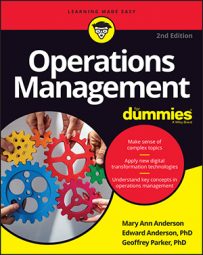Creating accurate and useful process maps requires considerable time and resources, but these maps are vital to any meaningful operations management process evaluation and improvement effort. Here’s some advice for creating an accurate process map:
Always ask why. While constructing an initial process map, find out why certain actions are being done. In many cases, the answer is “We’ve always done it this way” or “That’s the way they told me to do it.” The question “why” often reveals good places to begin improvement efforts.
Be prepared to revise the process map. When you first complete a process map, consider it a rough draft. You won’t get everything right the first time around. In fact, the first few times you review your process map with line workers and management (which you must do!), new wrinkles in the process will inevitably turn up.
When developing your first version of a process map, assume nothing is trivial. Document everything, including informal communications. The piece of information shared at the coffee machine every morning may turn out to be what keeps a certain process moving.
Beware of resistance. Feeling protective and even defensive is human nature, especially if someone feels that her job is at stake or otherwise threatened. Employees often view the mapping process and process-improvement projects as a way for company leaders to reduce payrolls and eliminate jobs. It is important to explain the purpose and benefits of the project before you start.
The general approach could include the message that process improvement is necessary to keep the company competitive and that a company must be competitive to provide jobs. Be aware of possible resistance during the mapping process and carefully examine what’s occurring at each process step to make certain that what you’re being told is actually being done so that you can build an accurate map.
Create a hierarchy of maps. Process maps can become very complex, and creating maps with increasing detail may be important to some businesses. Start with a high-level aggregated representation of the process in question and then break down each operation until you reach a level where meaningful analysis can take place. Avoid making a single map that’s so complicated it’s difficult to understand and communicate to stakeholders.
Determining what level of breakdown is necessary for a process can be difficult. A high-level map that references general activities is great for communicating with upper management, who tend to be primarily concerned with where handoffs occur between groups/departments or across reporting structures. More detail is important when a process map is intended to train employees or inform middle managers, who need to see where changes occur in resource requirements.
Document everything necessary to perform each task and the output of each task. A record that includes all resources and any information needed to complete a given task ensures consistency. Many people forget that the information an operation generates can be as important as the tangible resources.
For example, on a process-improvement project, an operation was identified as non-value-added and eliminated, but it actually produced a vital report needed later in the process. When the operations management team members completed the initial process map, they overlooked the existence and importance of this document, so when they implemented the new process, the system broke down because of the lack of information in the report.
Solicit input from all levels of the organization. It’s important to obtain input from the range of people involved in the process. Conduct interviews with those on the line doing the actual work as well as with company leaders.
We’re routinely surprised by how many managers don’t know exactly how work gets done in their firm. A fatal operations mistake is developing a process map with only management involvement.
Walk the process yourself. If possible, observe the process in question. Often, information from front-line staff, line workers, and managerial data is wrong or misleading. If what you see and what you’re told don’t match, find out why discrepancies exist. Through direct observation and follow-up conversations, you may discover critical insight into why a process behaves the way it does.

